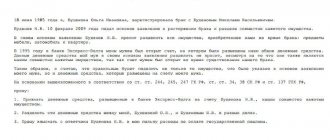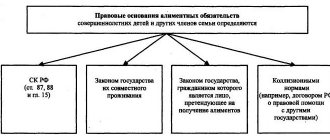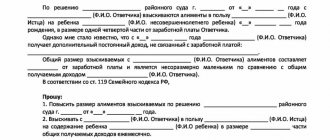Free initial consultation with a lawyer Let's look at your legal situation or question. We'll tell you what to do next. Call - it's free:
- For residents of Moscow and Moscow Region:
- Other regions of Russia:
Also write to us via online chat or form on the website.
The statement of claim to determine the final amount of alimony debt is submitted to the court. The reason for the dispute is a situation in which the amount of the current debt, established by the bailiff, violates the specific interests of the parties involved in the process.
In order to correctly collect imposed alimony, you need to prepare statements of claim to the court (as an option, it is possible to conclude an agreement on the voluntary payment of alimony). Regarding the process of withholding alimony, the issues that arise can be resolved exclusively by a bailiff appointed by the court.
The fact of receiving alimony established by the court occurs once; in the future, you can change the final amount, accept the order of their transfer, calculation, and subsequent method of payment.
Who makes a decision regarding arrears of child support?
The bailiff does not have the legal right to refuse to provide information about the amount of debt of the alimony payer to the recipient.
The bailiff is obliged to consider the application within 10 days from the date of its receipt. A day after the decision on the calculation of the debt is issued, the bailiff is obliged to send two copies of it - one for the recipient of alimony and the other for his payer.
It is important to note that this document, like all other decisions made by the bailiff in the framework of enforcement proceedings, has the form of a resolution and only that. There are exceptions here - namely, the calculation of the amount of the share can be drawn up as a separate document, but it is still attached to the resolution.
The resolution itself must contain the following information:
- On what basis is the debt calculated within the framework of alimony obligations (in other words, this is a statement);
- Information about each of the parties (the alimony payer and the alimony recipient);
- The billing period during which no payments were made and the debt was not directly calculated;
- Method of calculation (one of several: according to the cost of living, according to the average salary, according to the official salary of the alimony debtor);
- The amount of debt.
How to write an application for deduction of alimony from wages, read here.
Most often, this document is used by the alimony recipient for the purpose of filing a claim with the court to collect the alimony debt. It is important to note that although this paper is not mandatory for the court, its legal importance is great enough to make the document significant evidence of the existence of a debt, so it is still better to attach it to the application.
The recipient also has the right to use the document with the calculation of alimony to file a claim in court demanding an increase in the amount of debt due to indexation or the collection of additional funds as a penalty for alimony.
Calculation of debt on alimony payments may be necessary not only for the alimony payer, but also for the debtor. For example, he can use this document when filing a lawsuit in court with a demand to reduce the amount of debt or even eliminate it altogether, if there are legal grounds for this.
Grounds for debt collection
Debt in the payment of alimony, as a rule, arises for reasons related to the dishonesty of the alimony payer, for example, non-payment for the purpose of further challenging a court decision or with the expectation of a change in financial situation, a possible challenge of paternity and the further disappearance of the grounds for such payments. Some don’t transfer the full amount at all, hoping that the shortfall will not be noticed by the alimony recipient.
If these situations arise, the person receiving alimony payments has the right to contact the bailiffs or the courts with a statement of claim. According to practice, such claims are filed in the following circumstances:
- In the absence of a court decision obliging the debtor to pay alimony, or a voluntary agreement between the alimony recipient and the payer, the debtor’s actions regarding refusal to make payments are subject to appeal only within a three-year period. For example, if the ex-wife applied to the court with a request to collect alimony debt for four years, then only the amount of debt that has accumulated for three years from the moment it arose will be recovered from the defendant. Such collection of alimony debt is mainly carried out retroactively.
- If the alimony payer, due to the absence of an appropriate court decision and agreement between the alimony recipient, nevertheless paid alimony voluntarily and on time, but at some point stopped doing so, then the amount of such debt can also be recovered from the latter in court for the period when funds have ceased to arrive to the recipient's account. As a rule, such a debt is subject to recovery in hard currency or from a portion of the income received by the debtor.
- In case of disagreement with the amount of debt determined by the bailiff, if the latter was formed on the basis of a valid writ of execution. However, this issue can also be resolved by appealing the actions of the bailiff, which will clearly make it possible to quickly consider the requirements and make a decision.
IMPORTANT: The presence of a court decision on the payment of alimony or a corresponding agreement allows you to recover the unpaid amount in full from an unscrupulous payer, and for any period of such debt, it does not matter whether it is the last six months or fifteen years.
In this case, the key point will be to preserve all primary executive documentation confirming the existence of the debt. In this case, going to court will not be necessary; interaction with the FSSP service in which the sheet or court order is being executed is sufficient.
Cancellation of the resolution on the calculation of alimony arrears
The bailiff is authorized to independently cancel the act before it gains legal force, that is, in the first 10 days from the moment it was adopted. An example of such a situation: the calculation of the amount of debt was made based on the level of the average salary, since the debtor for alimony is on the wanted list, which is why it is not possible to find out his financial situation and sources of income (according to paragraph 4 of Article 113 of the RF IC).
At this time, the debtor is declared and presents certificates stating that he is unemployed or that he received money in a specific amount that exceeds or does not reach the subsistence level. These documents are sufficient grounds for canceling the act without consequences.
The full list of cases when a decision can be canceled is as follows:
- A penalty accrues;
- The person was deprived of his rights;
- A criminal case was opened in connection with malicious non-payment of alimony;
- The place of residence of the minor was determined, a ban was imposed on him leaving the country accompanied by the alimony debtor, or the parent’s communication with him was stopped.
Challenging the decision on the calculation of alimony arrears
If the bailiff responsible for your case is inactive or commits actions that are contrary to the law, you can appeal the order issued by him regarding the calculation of the alimony debt. It is important to note that the petition must be filed within the first 10 days from the moment you learn of a violation of your rights. Both the alimony recipient and the alimony payer have the right to submit a petition.
The calculation consists of information about all periods of non-payment of child support by the parent who left the family. It is also possible to split the amount by month or quarter and formulate the total amount of debt.
The complaint is filed in the order of subordination to a higher official, that is, it is sent to the head of the bailiff department or to the court against the actions (or, conversely, inaction) of civil service employees.
When is alimony debt calculated?
Calculation of alimony debt is carried out in the following situations:
- the spouses executed a voluntary agreement on alimony, specifying in this document all the conditions regarding the amount and procedure for transferring funds to minor children, after which they certified the document from an employee of a notary agency;
- the parent left with the children went to court and received a court order to collect child support payments.
If a person does not pay alimony, but the interested party did not previously apply for these payments, and then unexpectedly decided to sue to collect the money, then there is no debt in this case. The plaintiff can only recover funds for the past time, but there are few grounds for a positive court decision.
If there is arrears of alimony, it is only possible to demand collection of funds for the past 36 months. Even if the writ of execution was issued by bailiffs 6 years ago, the debt will be calculated only for the past 3 years. But this rule also has an exception: if the parent evaded fulfilling his alimony obligations, then the funds will be collected for the entire period of non-payment, and not for 36 months.
If the debt arose as a result of a court decision, is a lawsuit necessary?
If alimony debt arose due to non-execution of a court decision, you can file a claim in court only if you disagree with its amount. There is no point in demanding once again the payment of the debt that has already been determined on the basis of a court decision - the court will still refuse to accept such an application.
To speed up the debt collection process, you can:
- Submit a written request to the FSSP service, where you can request all enforcement actions taken;
- Appeal the actions of the bailiff;
- Submit an application to bring the debtor to criminal liability.
The listed actions do not deprive the creditor of the right through the court to demand recovery of the amount of debt that the bailiffs, in his opinion, did not calculate correctly.
How is alimony calculated?
You can calculate your child support debt in the following ways:
- on average wages in the Russian Federation;
- based on the cost of living determined in the Russian Federation or the region of residence of the parents (if the debtor does not work);
- according to the income of the alimony provider.
Calculation of debt according to average salary
The court orders alimony in this form in the following situations:
- the alimony refuses to provide certificates of income received or does not have such documents;
- the alimony worker does not officially work;
- the payer has no source of income.
In this case, the following formula is used to calculate the amount of debt:
(average salary - the share of alimony established in court or on the basis of an alimony agreement) * number of billing months = amount of debt.
The average salary is constantly changing, as a result of which the accumulated debt is recalculated quarterly.
Calculation of debt according to the cost of living
If the court has decided that alimony payments will be collected in a fixed amount, then they are calculated according to the subsistence level. The amount of salary and other income of the alimony worker is not included in the accounting. The amount of alimony is set as a multiple of the minimum subsistence level at the discretion of the court.
Every quarter, the cost of living undergoes changes, so the bailiff calculates the debt quarterly and indexes the size of the elements.
Debt in such a situation is calculated as follows:
the amount of alimony established in court * the amount of the subsistence minimum in the billing period in a particular city * the duration of evasion of alimony payments = the amount of debt generated.
Calculation of debt according to the income of the alimony worker
An alimony agreement or a court establishes alimony in this way if the parent’s official earnings are in the following amount:
- one child – up to 25% of the parent’s income;
- two children – up to 33% of income;
- for three or more minors – half the parent’s earnings.
If the alimony worker is officially employed, but alimony was not withheld from his source of income for a certain period of time, then the debt is determined as follows:
- The bailiff sets the amount of the alimony worker’s salary from which alimony payments can be collected;
- Personal income tax in the amount of 13% is collected from salaries;
- alimony payments are deducted from the amount remaining;
- the amount of money received is multiplied by the number of months during which the debtor evaded his financial obligations.
Example: A man drew up an alimony agreement with his ex-wife, and then had the document certified by an employee of a notary agency. For 2 years, the parent transferred alimony for a minor child in the amount of 10 thousand rubles with a salary of 40 thousand after deduction of personal income tax, which was determined by a voluntary agreement of the former spouses. However, over the past 3 months, the man has been avoiding alimony payments, explaining his behavior by having a car loan. The parent refused to pay child support.
As a result, after 30 months, the spouse filed an application for evasion of alimony, and the bailiff calculated the debt as follows: over the last 3 months, the man’s after-tax income amounted to 120 thousand rubles, and the debt from this earnings is equal to 30 thousand. With the decision, the woman went to court and collected the debt along with the penalty. The court did not consider the availability of a car loan to be a sufficient basis for getting rid of financial obligations.
6.6. Determination of alimony debtAs a general rule, the collection of alimony under a writ of execution or an agreement of the parties to pay alimony for the past is carried out within a three-year period preceding the presentation of a writ of execution or a notarized agreement of the parties on the payment of alimony to be collected (clause 1 of Article 113 of the Family Code). It follows that alimony arrears can arise only after the court makes a decision to collect alimony or the parties enter into an agreement on the payment of alimony, when in fact the payment of alimony according to the specified documents was not carried out. This is the difference between the collection of alimony debt and the collection of alimony for the past period, i.e. from the moment the right to alimony arises until the moment the person entitled to receive alimony goes to court (clause 2 of Article 107 of the Family Code). The time frame for collecting alimony arrears for the past within a three-year period is valid only in cases where the alimony arrears arose for reasons not related to the guilty actions of the person obliged to pay alimony, for example, due to the failure of the alimony recipient to present a writ of execution or a notarized agreement about the payment of alimony for collection (i.e. due to the fault of the recipient of the alimony). Debt in the payment of alimony can arise: due to delays in the payment of wages in the organization where the alimony payer works and his lack of other means to pay alimony; through the fault of postal services when the debtor transfers alimony payments by mail; due to illness of the alimony payer; due to the presence of one of the parties in the territory where military operations are taking place or a man-made or natural disaster has occurred, etc. (i.e., due to circumstances beyond the control of the parties). If the withholding of alimony on the basis of a notarized agreement on the payment of alimony or a writ of execution was not made through the fault of the debtor, then alimony is collected for the entire period during which it was not paid, even if its duration exceeds a three-year period (clause 2 of article 113 of the Criminal Code ). Previously, the legislation in force did not allow such a possibility in all cases of guilty behavior of the alimony payer, but only when he was searched by internal affairs bodies, regardless of the payment of benefits for minor children to the alimony claimant during the search period (Part 2 of Article 96 of the Code of Laws of Ukraine). The Investigative Committee gives the right to collect arrears of alimony resulting from the fault of the person obligated to pay alimony, regardless of whether or not he was wanted by the internal affairs bodies. The guilty behavior of the alimony payer, which resulted in the formation of a debt, should be understood not only as his refusal to pay alimony, but also the commission of any actions that impede the correct and timely collection of alimony: concealment of his earnings, income, property, failure to inform the recipient of alimony or the bailiff about change of place of residence or work, etc. Calculation of the amount of arrears on alimony payments by law (clause 3 of Article 113 of the Family Code) is entrusted to the bailiff, who is guided by the amount of alimony established by a court decision or agreement of the parties. This procedure consists of the bailiff calculating the amount of alimony for each month of the period during which alimony was not collected (in shares of the payer’s earnings (income) or in a fixed sum of money - when paying alimony for minor children; in a fixed sum of money - when paying alimony for other family members) with their subsequent summation for the entire period. For example, the obligated person (parent), according to a court decision, had to pay 980 rubles monthly for the maintenance of a disabled adult child. Alimony was not collected for 8 months. The amount of debt will be 980 rubles. x 8 = 7840 rub. In addition, if during this period of time the minimum wage established by law was increased, then in accordance with Art. 117 of the IC, the bailiff must index alimony payments. In order to protect the rights of minor children, paragraph 4 of Art. 113 of the IC provides that the amount of arrears of alimony paid for their maintenance in accordance with Art. 81 of the IC (i.e. in shares of the earnings or income of the alimony payer), is determined based on the actual earnings and other income of the debtor for the time during which alimony was not paid. If the alimony payer did not work during this period or did not provide documents confirming his earnings or other income, then the alimony arrears are determined based on the average salary in the Russian Federation at the time of debt collection. Such a rule for determining alimony arrears was introduced back in the KoBS (Article 96) by Federal Law No. 73-F3 of December 22, 1994, instead of the previously existing procedure, when the amount of alimony arrears was calculated based on the average salary for a given area. When a bailiff determines arrears of alimony paid for minor children, based on the average salary in the Russian Federation, any of the parties believing that its interests have been significantly violated (for example, when the alimony collector and the alimony payer for a minor child live in different subjects of the Russian Federation with different levels of average income of the population or if during the period of debt formation the alimony payer did not work for a good reason and did not have any income, etc.), may apply to the court with a request to determine the debt in a fixed amount. The court, when considering such a claim, can determine the debt in a fixed amount of money, based on the financial and family status of the parties and other noteworthy circumstances. In this case, the court must find out all the circumstances of the case that are important for correctly establishing the amount of arrears for alimony for minor children, otherwise the interests of one of the parties may be infringed. In this regard, the following ruling of the Judicial Collegium for Civil Cases of the Supreme Court of the Russian Federation dated June 6, 1997 is characteristic. Based on the decision of the Yaroslavl District People's Court of Yakutsk dated September 26, 1984, Nikiforov is obliged to pay alimony in favor of Nikiforova for two children. Nikiforova appealed to the Yakutsk City Court with a statement in which she asked to determine and collect alimony arrears from Nikiforov, citing the fact that the defendant, working as the director of the small enterprise "Kostyk", evades paying alimony, has a debt that he does not repay. On March 29, 1996, the Yakut City Court recovered from Nikiforov in favor of Nikiforova arrears of alimony in the amount of 137,819,398 rubles, as well as compensation for moral damage in the amount of 20 million rubles. The Presidium of the Supreme Court of the Republic of Sakha (Yakutia) overturned the court's decision regarding compensation for moral damage and made a new decision to refuse compensation, but otherwise left the decision unchanged. The Deputy Chairman of the Supreme Court of the Russian Federation in protest raised the issue of canceling the decision and resolution of the Presidium of the Supreme Court of the Republic of Sakha (Yakutia) regarding determining the amount of alimony debt. On June 6, 1997, the Judicial Collegium for Civil Cases of the Supreme Court of the Russian Federation satisfied the protest on the following grounds. According to Part 4 of Art. 113 SK amount of arrears of alimony paid for minor children in accordance with Art. 81 of the Family Code, is determined based on the earnings and other income of the person obliged to pay alimony for the period during which alimony was not collected. In cases where the person obligated to pay alimony did not work during this period or if documents confirming his earnings and (or) other income are not presented, alimony arrears are determined based on the average salary in the Russian Federation at the time of debt collection. If such a determination of the debt violates the interests of one of the parties, the party whose interests are violated has the right to go to court, which can determine the debt in a fixed amount of money based on the financial and family status of the parties and other noteworthy circumstances. As can be seen from the case materials, alimony deductions were made at the debtor’s other place of work, but there is no data on the deduction of alimony at his place of work in the Kostyk MP, and there is also no information about the sending of a writ of execution to this enterprise. In addition, the defendant argued that he had been in arrears for alimony not since the second half of 1992 (as the plaintiff indicated), but since October 1994, since the Kostyk enterprise had no income, was unprofitable and did not work. When making the decision, the court proceeded from the fact that the defendant did not provide evidence of payment of alimony until October 1994, but according to the calculations of the bailiff, he was in arrears for alimony since the second half of 1992. According to the act of inspection of the economic activities of the Kostyk MP, this enterprise had income from economic activities: in the second half of 1992 - 1,489,900 rubles, in the first half of 1993 - 16,259,200 rubles. and, besides this, hidden income. In this regard, the court came to the conclusion that the amount of debt should be determined based on average earnings in the Russian Federation and indexed in proportion to the increase in the minimum wage. But the court did not calculate the amount of alimony debt (monthly), but indicated in the decision only the final amount after indexation: for the second half of 1992 - 37,325,442 rubles; for the first half of 1993 until the day the decision was made - 29,403,867 rubles; total - RUB 137,819,398. As a result, it is impossible to determine from what amounts the debt was calculated, what amount was indexed, or whether the court correctly determined the total amount of alimony debt. The absence of a monthly calculation in the decision makes it impossible to verify the defendant’s arguments in the supervisory complaint that the amount of debt was calculated not from his income, but from the income of the enterprise, including from loans received, without taking into account the fact that he is not the only founder of the enterprise. As can be seen from the case, the amount of alimony debt is determined based on “income”, without specifying the income of the enterprise or the debtor. However, the indicated amounts of income correspond to the amounts of income of the small enterprise “Kostyk” according to the audit report of its financial activities dated January 10, 1994. There are no certificates on average earnings in the Russian Federation in the case. The amount of debt was determined based on earnings in the amount of 430,000 rubles. for the period from the second half of 1993 to February 1996 (including indexation), but there is no justification for this amount of earnings either in the case materials or in the decision. It is impossible to verify the defendant’s arguments about the incorrect calculation of the amount of alimony debt. The Presidium of the Supreme Court of the Republic of Sakha (Yakutia) correctly overturned the decision on compensation for moral damage and made a new decision to reject this claim, but ignored the court’s errors in determining the amount of debt. Under such circumstances, court decisions regarding the determination of alimony debt cannot be recognized as meeting the requirements of Part 4 of Art. 113 SK and Art. 14 of the Code of Civil Procedure of the RSFSR, they are subject to cancellation in the specified part, and the case is subject to referral for a new consideration. As noted earlier, the amount of alimony debt is determined by the bailiff. The amount of alimony debt established by the bailiff is indicated in the accompanying letter to the writ of execution (court order) or a notarized agreement on the payment of alimony, sent to the administration of the organization at the place of work of the person obliged to pay alimony. In cases where the alimony collector or debtor disagrees with the amount of alimony debt determined by the bailiff, they can appeal the actions of the bailiff to the court in the manner prescribed by law. The procedure for appealing the actions of a bailiff is determined, in particular, by Art. 441 Code of Civil Procedure and Art. 90 of the Law on Enforcement Proceedings. The complaint is filed with the court at the location of the bailiff within ten days from the day the bailiff performed the action or from the day when the claimant or debtor, who was not notified of the time and place of the enforcement action, became aware of it. The complaint is considered by a judge in a court session with preliminary notification of the interested parties about the time and place of the hearing. Based on the results of consideration of the complaint, a court decision is made. In the interests of minor children, the state provides a number of measures to ensure their maintenance in cases where parents do not pay child support. Thus, the amount of the monthly benefit for children whose parents evade paying alimony or in other cases when collecting alimony is impossible increases by 50%. For example, the monthly allowance for children increases if a court decision (judge's decision) to collect child support from persons obligated to pay it is not executed due to their search by internal affairs bodies on the basis of court rulings and decisions of investigative bodies in connection with evasion of payment alimony, criminal prosecution for committing a crime; due to the lack of earnings among alimony payers, from which alimony can be collected while they are serving their sentences in correctional labor institutions, while they are under arrest, and for other reasons. Payment of an increased monthly allowance for a child in connection with the search for his parents who are evading payment of alimony is terminated only when the place of residence (location) of the parent is established. Previously, the internal affairs bodies are obliged to notify the alimony claimant, the social protection body paying the monthly child benefit, the official who issued the search warrant, as well as the court at the location of the writ of execution, within three days. In accordance with paragraph 6 of Art. 113 of the SK, the amount of monthly child benefit in terms of their 50% increase, paid for the entire period of searching for his parents who are evading payment of alimony, is recovered from these parents after establishing their whereabouts to the income of the budgets of the constituent entities of the Russian Federation. In addition, an additional 10% is charged on these amounts, which also goes to the budget of the corresponding constituent entity of the Russian Federation. This measure is intended to reimburse budget costs for paying child benefits in an increased amount and to encourage the alimony payer to properly fulfill his duties. Demands to recover from parents the amounts paid by which state benefits for children were increased are equivalent to demands for the payment of alimony. However, first of all, the requirements for the collection of alimony and arrears thereof must be satisfied, and then the requirements for the collection of the amounts of paid benefits in terms of their 50% increase with an accrual of 10%. It should be borne in mind that internal affairs bodies have the right to recover the costs of searching for a person evading payment of alimony, for which they apply to the court. Based on the demand stated by the internal affairs body, the judge alone issues a corresponding court order, which is issued to the claimant for execution or, at his request, sent by the court to the bailiff for execution (Articles 122, 130 of the Code of Civil Procedure).
Statement of claim for calculation of alimony debt: sample
Calculation of court debt is the responsibility of the bailiff, but if this employee does not independently determine the amount of the debt. In this case, the recipient of alimony payments will need to draw up a corresponding statement and send it to the bailiff who is handling the case for collecting payments. The official has no right to refuse to consider the application.
The application is submitted in two copies - one each for the claimant of payments and for the bailiff. The document contains the following information:
- name of the bailiff service;
- information about the applicant – full name without abbreviations, residential address, contact telephone number;
- information about the alimony provider;
- information about a minor child;
- information about the initiation of enforcement proceedings against the parent;
- information about the last transferred payment for a minor;
- an indication of the reasons why the claimant no longer received alimony payments;
- please establish the amount of debt generated for the specified period;
- list of documentation attached to the application;
- date of application, signature of the person applying.
How to make an application
You can check your debt without contacting bailiffs, on the FSSP website or the State Services portal. However, in some cases a written document is required. For example, when going to court.
The rules for filing an application are regulated in Art. 50 Federal Law “On Enforcement Proceedings”. You need to contact the bailiff handling the case. This must be done after several months (at least three) have passed since the last payment. When enforcement proceedings are not opened, the documents are transferred to the head of the bailiff service. He will select an employee who will deal with the case and transfer the materials to him.
Expert commentary
Kolesnikova Anna
Lawyer
Not only the debt collector, but also the payer can submit an application for debt settlement. This can also be done by a representative of the parties on the basis of a power of attorney. Write an application in free form by hand or on a computer, adhering to the general rules of office work:
The application must show:
- in the upper right corner fill out the “header” of the document. Here indicate the name of the bailiff service and the applicant’s details: full name, address, contact phone number;
- in the center they write the name of the document: “Application for calculation of alimony debt”;
- Next comes the content part. Here they write the date of initiation of enforcement proceedings and the document on the basis of which it was opened. Indicate your full name. all persons involved in the process: the payer, the recipient, the bailiff in charge of the case, and the minor for whom alimony is paid. Next, they report the date when the money was last received and the amount of payment. They also indicate the reason why the receipt of payments stopped, and the need to determine the amount of the resulting debt is indicated;
- the final part is a request to calculate the alimony debt and the period for which this is required;
- then the applicant lists the list of documents attached to the application, puts a date and signature.
Application for calculation of alimony debt (sample)
It is advisable to prepare the application in two identical copies. One is handed over to the bailiff service, the second is marked with acceptance and returned to the submitter. If the applicant cannot personally come to the bailiff department, the document can be submitted through:
- Representative by proxy. At the same time, it is important to register the application in the office (reception) in order to record the fact of its acceptance by the state body;
- Postal services, sending all papers by registered mail with acknowledgment of receipt of the letter.
Resolution on the calculation of accumulated debt
After the bailiff has received the application, he considers it within a 10-day period, and then makes a decision on the calculation of the debt and sends both parties a copy of this document.
The resolution contains the following information:
- a statement from the debtor, serving as the basis for calculating alimony debt;
- information about the parties;
- the settlement period during which the alimony holder avoided fulfilling his financial obligations;
- the calculation method used - for example, according to the average salary in the Russian Federation or the cost of living established in the area of residence of the parents;
- the amount of debt generated.
The completed resolution can be used to go to court. This document is proof of the existence of arrears of alimony and confirmation of the requirements specified in the applicant’s claim. The resolution can also be used to ask the court to increase the amount of debt on the basis of collecting a penalty or indexing payments.
This resolution can also be used by the debtor if he intends to ask the court to release himself from financial obligations or reduce the amount of the accrued debt. The following factors may be the basis for this:
- serious illness that deprived the debtor of his ability to work;
- deteriorated financial condition (liquidation of the enterprise where the parent worked);
- the emergence of new dependents requiring financial support (elderly parents, small children from a new marriage, close relatives with disabilities);
- changes in the marital status of the parties (the woman remarried a new man).
If alimony was not transferred to the recipient of payments due to the fault of third parties (for example, due to an error made by the company’s accountant)... In such cases, the alimony provider is released from the obligation to repay the debt, and third parties face a fine.
Let's sum it up
If the alimony provider has not transferred funds to the child for a long time, and the bailiff is inactive, then the recipient of the alimony has the right to send this employee an application for settlement of the debt. In the future, the debt resolution can be used to go to court, which will take all necessary measures to pay off the accumulated debt.
The debt is calculated according to the method chosen for collecting alimony. For example, according to the salary of the alimony worker, the average income or the cost of living established at the federal level or the region of residence of the parents.
If there are compelling reasons, the alimony holder has the right to apply to the court with a request to reduce the amount of alimony or completely exempt himself from it. The court takes many factors into account when considering a case.
If you want to find out how to solve your particular problem, please use the online consultant form below or call :
How statements of claim are drawn up in court
When there is a debt for alimony, the right to go to court with a legal filing of an application regarding the fact of the debt, setting out the circumstances for recalculating the amount. You can apply if the debt was formed due to the debtor’s illness, when he was deprived of the opportunity to work fully. The main thing is the presence of a valid and compelling reason based on the current financial status and marital status.
The appeal is typical for the following cases:
- When the amount established by the bailiff in practice violates the rights of the child defined by law and does not allow him to guarantee a decent standard of living;
- There is a situation in which the income of one of the parents (positioned as a debtor) during the period of debt formation was small, and after a while, the financial situation improved somewhat.
In the above cases, a sample statement of claim is considered and filled out to determine the exact amount of alimony debt of one of the parties.
When submitting a completed claim to the court, the subsequent receipt of funds is carried out in hard currency. A document is prepared and submitted to the magistrate, directly according to the actual residence of the person. It is mandatory to pay a state fee, the specific value of which is established by current legislation. The price of the claim itself is established solely on the basis of the amount; it is reduced by it in the future, but the established amount of payments requested by the plaintiff may also increase.
Resolution - calculation of alimony debt
The resolution on the calculation of alimony arrears is made by the bailiff who conducts enforcement proceedings. You cannot expect this from the bailiff on your own (on your own initiative), so in practice, if you need such a resolution, you need to submit a petition to the bailiff.
It often happens that it is enough to ask verbally; it has even happened that during reception hours you come to the bailiff, and he immediately, in front of you, makes a calculation and hands it over.
If this is not the case in your case, write a petition (you can right there, in the corridor of the bailiff service, by hand, on a blank sheet of paper) in any form: “ To the Leninsky ROSP from the collector, full name, address, debtor so and so. I ask you to issue a resolution on the calculation of arrears of alimony
". Signature, date.
A frequent question during consultations: can the bailiff then change his own calculation and reduce the amount of alimony debt?
The answer is yes, it can.
Usually this situation happens when at first the bailiff has not yet found the debtor, and made the calculation based on the average Russian salary (according to clause 4 of Article 113 of the Family Code of the Russian Federation). The result was one amount of debt, the decision was made, and even 10 days for the appeal passed, the debtor did not appeal, that is, it supposedly entered into legal force.
But then the debtor presents the bailiff with a certificate stating that he, it turns out, worked at such and such a job all these months, and his salary was such and such. And the bailiff issues a second resolution on the calculation of the alimony debt - based on the actual earnings received by the debtor.
Please note point 2:










